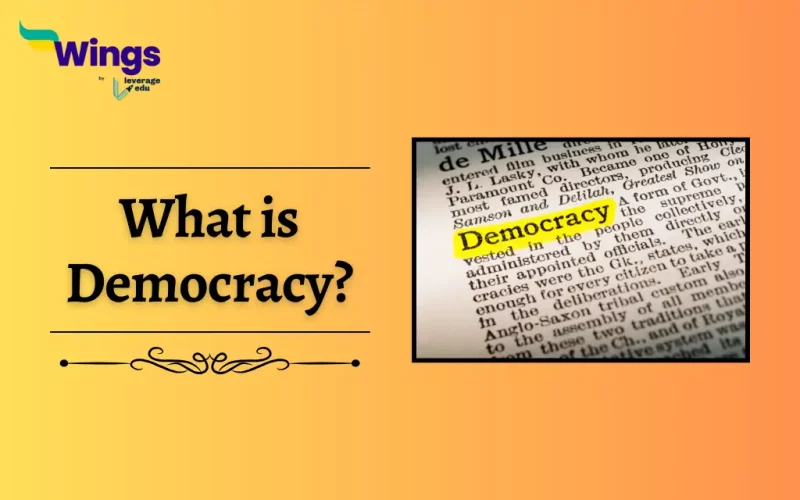Democracy is a type of political structure, doctrine, or system of government. Moreover, under which policies, laws, leadership, as well as the major undertakings of a State are directly or indirectly decided and elected by the people of that particular country. In this short article, we will understand what democracy is, what is its structure, its types, etc.
Table of Contents [show]
What is the Structure and Features of a Democracy?
Additionally, the following are the features and structure of a Democratic system:
- There is large citizen participation.
- Moreover, the government is elected by the people.
- The final decision-making power is always with those elected by the people.
- Furthermore, a democratic election must be free and based on fairness which means that those in power also have a fair chance of losing.
- A democratic structure provides each of its adult citizens one vote. Apart from this, each vote must have one value.
- Additionally, there is a multi-party political system.
- A democratic government must govern based on Constitutional law and the Rights of the citizens.
Also Read: What is Communism?
What are the Types of Democracies?
There are mainly two types of democratic structures, let us check them out!
What is Direct Democracy?
Direct democracy is essentially the purest form of democracy. It is a type of democracy under which the citizens of that country have the power to choose or elect their leaders directly.
- Moreover, there is no need for representatives who elect on their behalf or intermediaries under this process.
- Consequently, the citizens of the country vote on policies and laws through direct means.
- In addition, people use their supreme electoral power in the most direct form.
The four devices that work in a Direct Democracy are as follows:
- Initiative
- Recall
- Referendum
- Plebiscite
What is Representative Democracy?
Representative or Indirect democracy is when the citizens of that country elect representatives.
- These representatives make decisions on their behalf.
- Moreover, these representatives, who further elect ministers in the parliament, are generally elected by the common citizens through a voting system.
- Later these representatives go on to represent the citizens and make decisions on their behalf.
- An example of this type of Democracy is India.
Also Read: Left wing v/s Right wing
Which Countries Have Democratic Systems?
Additionally, the following countries have a democratic system of government:
- India
- Norway
- Australia
- Sweden
- USA
- New Zealand
- Ireland
- Canada
- Finland
- Denmark
- Switzerland
Also Read: 11 Features of Democracy
What are the Three Pillars of Democracy?
Moreover, the Three Pillars of Democracy are as follows:
- The Legislative
- The Executive
- The Judiciary
However, some believe that there are Four Pillars of Democracy with the Media being the fourth one!
Also Read: What is the Difference between Democracy and Dictatorship?
What is Democracy in India?
India is the world’s largest Democracy and functions as a Parliamentary Republic.
- Its core principle is that the people hold the power.
- This is reflected in Universal Adult Suffrage, where every citizen has the right to vote.
- The Constitution which was drafted after independence, guarantees Fundamental Rights like Equality and Freedom of Speech.
- India’s federal structure divides power between the Central government and States.
- Leaders are elected through regular elections, and the party (or coalition) with a majority in Parliament forms the government.
- Despite its strengths, Indian democracy faces challenges.
- The caste system’s influence persists, and social inequalities can hinder equal participation.
- Yet, India’s vibrant democracy, with its diverse voices and commitment to elections, continues to evolve.
Quiz
Results
#1. What are the different types of democracy?
#2. Which of the following countries does not have a democratic system of governance?
#3. When was the first known Democracy established?
FAQs
Democracy works on, as Abraham Lincoln, a government that is ‘of the people, by the people, and for the people.’ The people vote for their preferred representative directly or indirectly involving periodically held free elections.
Cleisthenes is known as the Father of Democracy. He founded Athenian democracy in Greece, one of the most important contributions to modern politics.
Related Blogs
Lastly, we hope you liked our blog and gained an understanding of what is Democracy. Moreover, you may even read more blogs and empower yourself with knowledge regarding Civics and Polity!
 One app for all your study abroad needs
One app for all your study abroad needs


















 45,000+ students trusted us with their dreams. Take the first step today!
45,000+ students trusted us with their dreams. Take the first step today!
